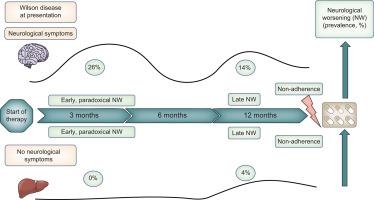Journal of Hepatology ( IF 26.8 ) Pub Date : 2023-04-26 , DOI: 10.1016/j.jhep.2023.04.007 Isabelle Mohr 1 , Jan Pfeiffenberger 1 , Ecem Eker 1 , Uta Merle 1 , Aurélia Poujois 2 , Aftab Ala 3 , Karl Heinz Weiss 4

|
Background & Aims
Prevention of neurological worsening (NW) under therapy is an unmet need in the management of Wilson disease (WD). In this study, we aimed to characterize the occurrence, associated outcomes and potential reversibility of NW in WD.
Methods
From a total cohort of 457 patients with WD, 128 patients with WD and neurological features at any time point (all Caucasian, 63 females, median age at diagnosis 22 years) were identified by chart review at University Hospital Heidelberg and grouped according to initial presentation. The timing and occurrence of NW was assessed following a structured clinical examination during clinical visits.
Results
Early NW (within the first 3 months of therapy) was observed in 30 out of 115 (26.1%) patients with neurological or mixed presentation and never in patients with a purely hepatic or asymptomatic presentation (0%). Late NW (after >12 months) was seen in a further 23 (20%) with neurological or mixed presentation and in 13 out of 294 (4.4%) patients with a hepatic or asymptomatic presentation. The median time from start of treatment to late NW was 20 months. Only three patients experienced NW between 3 and 12 months. NW was observed with D-penicillamine, trientine and zinc therapy and was reversible in 15/30 (50%) with early NW and in 29/36 (81%) with late NW.
Conclusions
In this study, we identified two peaks in NW: an early (≤3 months) treatment-associated peak and a late (>12 months of treatment) adherence-associated peak. Early paradoxical NW was attributed to treatment initiation and pre-existing neurological damage, and was not observed in those with a hepatic or asymptomatic presentation. Late NW is likely to be associated with non-adherence.
Impact and implications
In patients with Wilson disease, defined as an excess accumulation of copper which can damage the liver, brain and other vital organs, neurological worsening can occur despite chelation therapy. The study identifies different patterns of ‘early’ (<3 months) vs. ‘late’ (>12 months) neurological worsening in relation to initiation of chelation therapy and establishes possible causes and the potential for reversibility. These data should be useful for counseling patients and for guiding the optimal management of chelation therapy.
中文翻译:

威尔逊病的神经系统恶化——临床分类和结果
背景与目标
在治疗中预防神经功能恶化(NW)是威尔逊病(WD)治疗中未满足的需求。在本研究中,我们旨在描述 WD 中 NW 的发生、相关结果和潜在可逆性。
方法
海德堡大学医院通过图表审查从 457 名 WD 患者的队列中确定了 128 名任何时间点患有 WD 和神经学特征的患者(均为白人,63 名女性,诊断时中位年龄 22 岁),并根据初始表现进行分组。 NW 的发生时间和发生情况是在临床就诊期间进行结构化临床检查后进行评估的。
结果
在 115 名患有神经系统或混合症状的患者中,有 30 名 (26.1%) 观察到早期 NW(治疗的前 3 个月内),而在纯粹肝脏或无症状表现的患者中从未观察到 (0%)。另外 23 名 (20%) 患有神经系统或混合症状的患者以及 294 名患有肝脏或无症状症状的患者中,有 13 名 (4.4%) 出现晚期 NW(>12 个月后)。从治疗开始到 NW 晚期的中位时间为 20 个月。只有 3 名患者在 3 至 12 个月期间出现 NW。 D-青霉胺、曲恩汀和锌治疗中观察到 NW,早期 NW 的比例为 15/30 (50%),晚期 NW 的比例为 29/36 (81%)。
结论
在这项研究中,我们确定了 NW 的两个峰值:早期(≤3 个月)治疗相关峰值和晚期(> 12 个月治疗)依从性相关峰值。早期矛盾 NW 归因于治疗开始和先前存在的神经损伤,并且在有肝脏或无症状表现的患者中未观察到。 NW 晚可能与不依从性有关。
影响和影响
在患有威尔逊病(定义为铜过量积累,会损害肝脏、大脑和其他重要器官)的患者中,尽管进行了螯合治疗,神经功能仍可能恶化。该研究确定了与开始螯合治疗相关的“早期”(<3 个月)与“晚期”(>12 个月)神经功能恶化的不同模式,并确定了可能的原因和可逆性的可能性。这些数据应该有助于为患者提供咨询并指导螯合疗法的最佳管理。











































 京公网安备 11010802027423号
京公网安备 11010802027423号